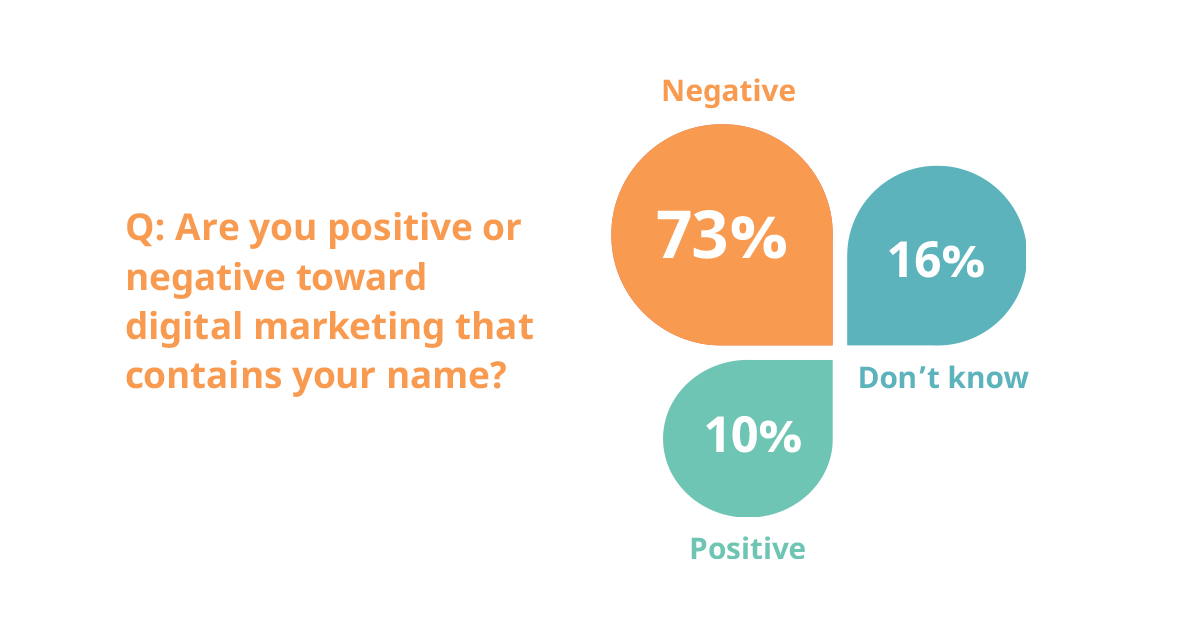5 Personalisation Mistakes – And Their Solutions
We personalise to add personal value. If done right, it can bring immense value to both your customers and your business. But there’s such a thing as too much of a good thing. And it can go downhill or get downright creepy, really, really fast. We don’t want you to tread down that path, so let’s explore 5 personalisation mistakes – and their solutions.

What is Personalisation?
Personalisation is about providing personally relevant experiences. This is done by (consensually!) gathering and processing data into customer-specific data collections called customer profiles. These provide you, as a marketer, with insights into your customers’ likes and dislikes.
Now, personalisation is not sprinkling your emails with demographic data fields to make it feel personal. Rather, it's the process of tailoring the entire customer experience to the individual.
How Data is Used for Personalisation
In a nutshell, personalisation is a method that intelligently uses data to sift out irrelevant clutter. Instead, visitors are presented with products and content people actually want. For instance:
- Personalised product recommendations, based on data points such as purchase history and page views.
- Automated flows: such as cart abandonment, browse abandonment, post-purchase emails, replenishment, birthdays, re-engagement...
- Website personalisation
Or, you can use them to create smart segments when you launch campaigns for events or specific product categories. The sky’s the limit!
When you set up shop for personalisation, you want to tread lightly. The line between providing a service and destroying the experience can be thin. And sometimes, it can go wrong. Really wrong...

1. Open Oversharing
Commercial stalking. We’ve all encountered it at least once. It’s when companies seem to follow – and display – your every step in the matrix.
But knowing a lot doesn’t automatically mean that you should share a lot. Think of personalisation in terms of a first date. You want to get to know the person, but you don’t want to blurt out that you saw a lovely picture of your date in Nørrebro with Aunt Sheila, do you?
THE FIX
Be tactile. Most customers are aware that companies process personal data. But don’t personalise everything just because you can. And stay cool. You don’t have to remarket product views as soon as people have ended their session.
Use behavioural data to steer your email campaigns and product recommendations, but you don’t need to simultaneously mention them by name or call out their city of residence. By keeping it simple and subtle by personalising where it counts, you’ll avoid the creepy label and encourage more engagement.
2. Tactless Retargeting
Recommendations and social media retargeting are great opportunities for cross-selling, upselling and to generally get people back to your website. But sometimes, social ads pop up even though you’ve already purchased the product advertised.
Dear Amazon, I bought a toilet seat because I needed one. Necessity, not desire. I do not collect them. I am not a toilet seat addict. No matter how temptingly you email me, I'm not going to think, oh go on then, just one more toilet seat, I'll treat myself.
— Jac Rayner (@GirlFromBlupo) April 6, 2018
I’ve encountered it many times, and I presume that you can identify with it too. But why did it make the list? Well, the answer is twofold. Firstly, it creates an impersonal, irrelevant and annoying customer experience that verges on clumsy stalking. Secondly, it can drain your budget.
THE FIX
The smoothest way is through a data platform with which enables you to gather customer data, such as online activities and transactional information, to customer profiles.

For product recommendations in emails or onsite, the key is to tailor them according to purchase and/or real-time browsing behaviour. This ensures that your recommendations are based on the actual person’s actions – rather than guesswork.
For a lot of people, social media like the Wild West where you have to pay to play. But if you want to gain control of your content and spend, you need to get on the data train.
The data variables that you collect in customer profiles can be fed into ad platforms to either include or – as in this case – exclude audiences. Bada bing, bada boom: Resource-drainage lost, customer relationships saved!
3. Profit Over Purpose: Not Delivering What You Promise
Personalisation is a means to an end. And that end is – and should always be – to improve the customer experience. But all too many brands get all starry-eyed when the monetary results pop up in the reports. All of a sudden, the purpose is placed on the backburner and the customer is treated as a cash cow.
Furthermore, it’s a violation of the user’s consent. No cookie banner states that tracking is used to sell or market more products. Quite the contrary: 99,5% state that cookies are used to improve the online experience. So what happens when you don’t deliver what you promise? Well, trust issues.
THE FIX
Albeit, personalisation drives sales. But when your sole goal is to sell more, it may be at the detriment of user experiences. Personalisation is a long-term investment in long-term customer relationships. Never let short-term results overshadow the quality of your communications.
4. Communicating with Frantic Frequency
January 15th, 15.05: Hello Sarah, you left something in your cart!
January 15th, 16.05: Sarah, don’t miss out!
January 15th, 20.05: Sarah, the items in your basket are selling out fast!
January 16th, 08.05: We miss you!
Another mistake is to breach the line between providing and pushing. Cart recovery and all forms of personal retargeting should serve as a reminder that the abandonee should return to your site.
If you include heaps of reminders in your cart abandonment flow or create a stalking experience on social media, you’re doing it wrong. Personalisation should be based on what a person wants to receive – not what you want to say, achieve or sell.
THE FIX
A dash of common sense and a large dose of analysis. A person might have ended a session because they’re running late for an event, too high total order value or poor delivery options. The cart or browsing session could’ve been abandoned due to any reason. So, as a company, you want to use retargeting to remind them. But you don’t want to force and nag.
Even though there’s no one-size-fits-all, the first abandoned cart email should generally be sent out after a couple of hours. Then, your system for marketing automation needs to take a chill pill and wait for another 24. At that point, the items remain top of mind, but not in an overbearing way.
5. Mundane First-Name Basis
Alright, this isn’t technically personalisation in its true sense. But adding a person’s name with the help of dynamic content with demographic data is normally the first step most marketers take toward a personal experience.
Well, according to the 4000+ respondents in our whitepaper about personalisation in the Nordics, only 10% of them feel positive toward marketing that contains their name. For a whopping 73.5%, it awakens negative feelings.

The reason behind this dire number might be that it feels overly personal and disingenuous – a sales gimmick. Regardless, first names don’t seem to hit home in the Nordic households.
THE FIX
The future-proof route is to get started with personalisation by setting common goals, getting to know your customers and selecting the solution that suits your business prerequisites and needs.
But hey. There’s always value in starting with the low-hanging fruit, right? Well, for starters, don’t create general content, slap a name on it and call it a personalised day. But if you filter your content after segments to make it more relevant or if the person has attended an event - go for it!
The Next Step: Getting Personalisation Right in the Nordics
There’s no denying that personalisation is the future of digital marketing. But with great power (improving the customer experience) comes great responsibility (doing it right). If used incorrectly, it can backfire immensely. But when you use it right, you’ll blow your competition out of the water and build stronger customer relations than ever before. Thankfully, there’s a lot of help out there.
Want to sharpen your personalisation efforts? Download our brand-new whitepaper: E-commerce Personalisation in the Nordics!
